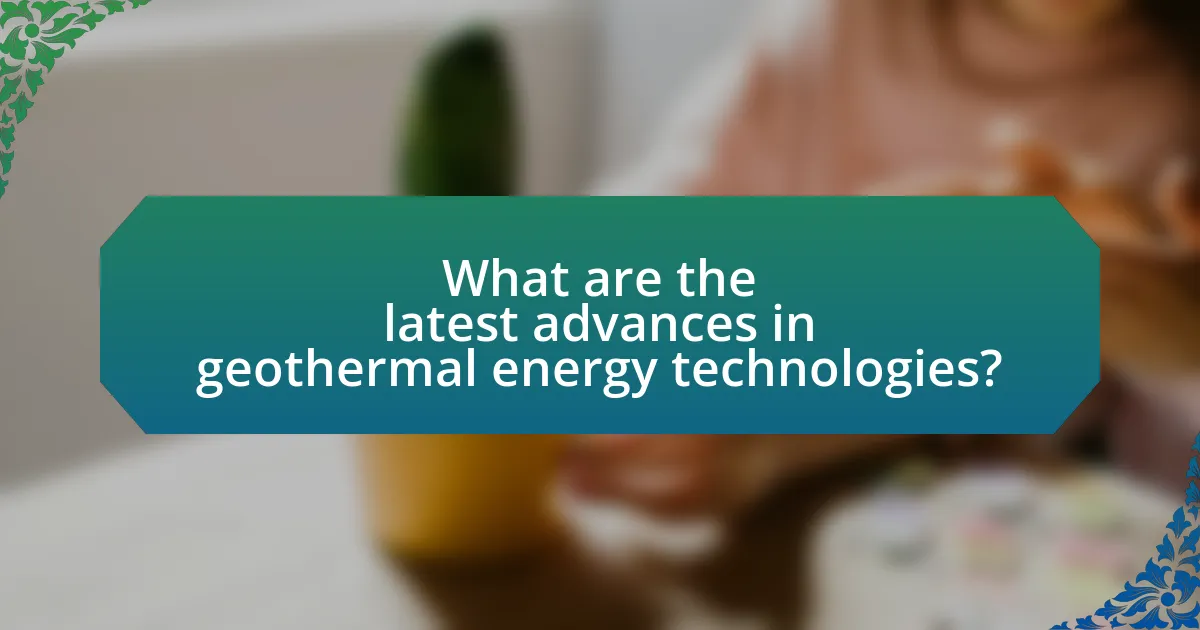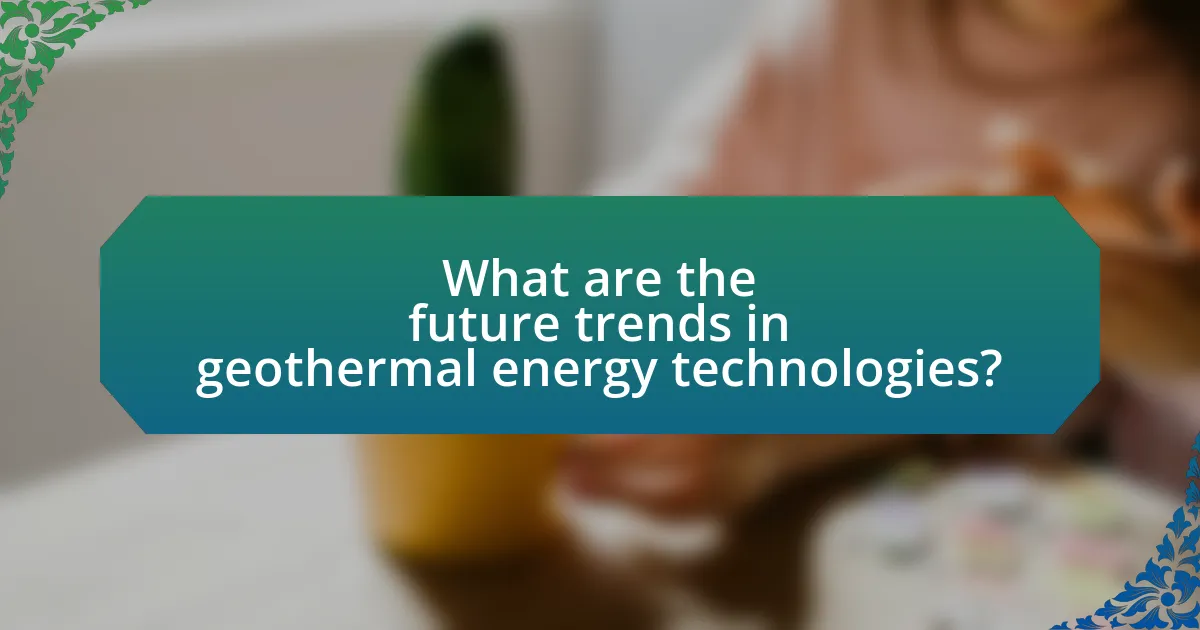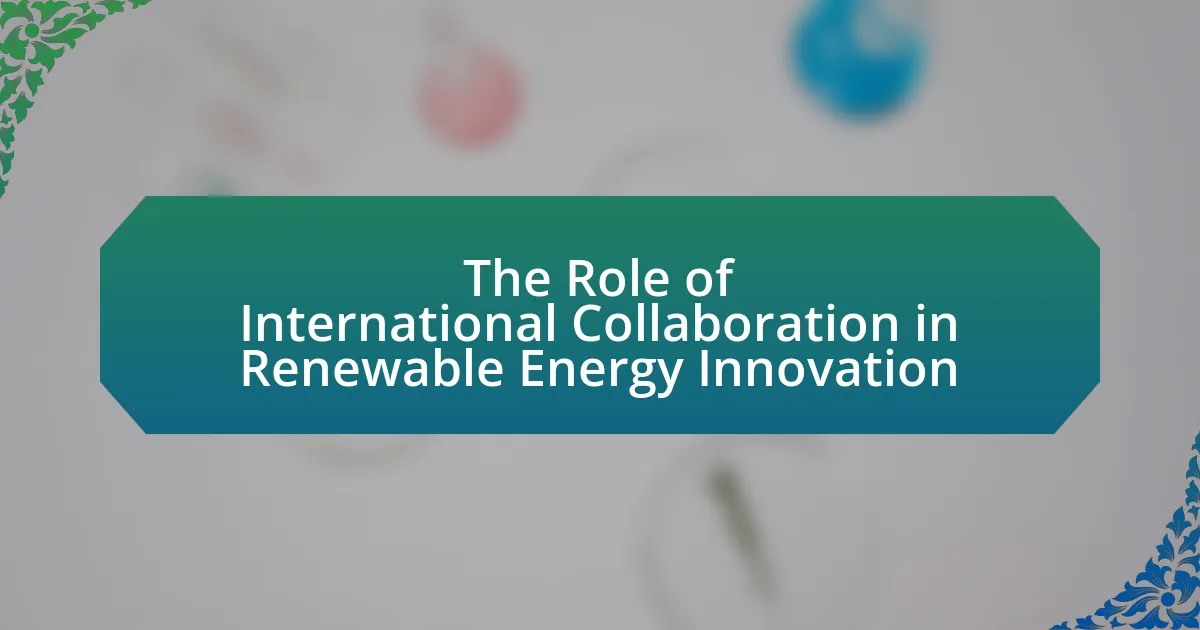The article focuses on the latest advances in geothermal energy technologies, highlighting innovations such as enhanced geothermal systems (EGS), improved drilling techniques, and binary cycle power plants. It discusses how these advancements enhance energy efficiency, expand resource accessibility, and reduce environmental impacts compared to traditional methods. The role of government policies in promoting geothermal energy development, as well as the economic implications and future trends in the sector, are also examined. Additionally, the article outlines practical steps for implementing advanced geothermal technologies and resources available for companies interested in investing in this renewable energy source.

What are the latest advances in geothermal energy technologies?
The latest advances in geothermal energy technologies include enhanced geothermal systems (EGS), which allow for energy extraction from previously untapped geothermal resources, and improved drilling techniques that reduce costs and increase efficiency. EGS utilizes hydraulic stimulation to create artificial reservoirs in hot rock formations, significantly expanding the potential for geothermal energy production beyond traditional hydrothermal sites. Additionally, advancements in drilling technologies, such as the use of high-temperature materials and automated drilling systems, have decreased the time and expense associated with accessing geothermal resources. These innovations are supported by research from institutions like the U.S. Department of Energy, which highlights the potential for geothermal energy to contribute significantly to renewable energy goals.
How have recent innovations improved geothermal energy efficiency?
Recent innovations have significantly improved geothermal energy efficiency through enhanced drilling techniques and advanced heat exchange systems. For instance, the development of directional drilling allows for deeper and more precise access to geothermal reservoirs, increasing the potential energy yield. Additionally, innovations such as enhanced geothermal systems (EGS) utilize hydraulic fracturing to create artificial reservoirs, which can dramatically expand the areas suitable for geothermal energy extraction. According to a study by the National Renewable Energy Laboratory, these advancements can increase the efficiency of geothermal plants by up to 20%, making geothermal energy a more viable and competitive renewable energy source.
What specific technologies have emerged in the last decade?
In the last decade, specific technologies that have emerged in geothermal energy include enhanced geothermal systems (EGS), binary cycle power plants, and advanced drilling techniques. Enhanced geothermal systems utilize artificial reservoirs to extract heat from the Earth, significantly increasing the potential for geothermal energy production. Binary cycle power plants allow for the generation of electricity from lower temperature geothermal resources by using a secondary fluid with a lower boiling point, thus expanding the range of viable geothermal sites. Advanced drilling techniques, such as improved rotary drilling and the use of high-temperature materials, have reduced costs and increased the efficiency of accessing geothermal resources. These advancements have been supported by research and development initiatives, including projects funded by the U.S. Department of Energy, which aim to enhance the feasibility and efficiency of geothermal energy as a renewable resource.
How do these innovations compare to traditional geothermal methods?
Innovations in geothermal energy technologies, such as enhanced geothermal systems (EGS) and closed-loop systems, offer greater efficiency and flexibility compared to traditional geothermal methods, which primarily rely on naturally occurring hydrothermal resources. Traditional methods are limited by geographic location and require significant water resources, while innovations can be deployed in a wider range of environments, including areas with low thermal gradients. For instance, EGS can create reservoirs in hot, dry rock formations, significantly expanding the potential for geothermal energy production. Additionally, closed-loop systems minimize water usage and environmental impact, addressing some of the sustainability concerns associated with traditional methods. These advancements not only enhance energy output but also reduce operational costs, making geothermal energy more competitive with other renewable sources.
What role do government policies play in advancing geothermal technologies?
Government policies play a crucial role in advancing geothermal technologies by providing funding, regulatory frameworks, and incentives that promote research, development, and deployment. For instance, policies such as tax credits, grants, and subsidies can significantly lower the financial barriers for geothermal projects, encouraging private investment. The U.S. Department of Energy has allocated over $100 million in recent years to support geothermal research and development, demonstrating the impact of government funding on technological advancements. Additionally, streamlined permitting processes and supportive regulations can facilitate faster project implementation, further accelerating the growth of the geothermal sector.
Which policies have been most effective in promoting geothermal energy?
The most effective policies in promoting geothermal energy include feed-in tariffs, tax incentives, and renewable energy portfolio standards. Feed-in tariffs guarantee fixed payments for energy produced from geothermal sources, encouraging investment and development. Tax incentives, such as investment tax credits, reduce the financial burden on developers, making geothermal projects more attractive. Renewable energy portfolio standards mandate a certain percentage of energy to come from renewable sources, including geothermal, driving demand and market growth. These policies have been implemented successfully in countries like the United States and Germany, leading to significant increases in geothermal capacity and investment.
How do international regulations impact geothermal technology development?
International regulations significantly influence geothermal technology development by establishing standards for environmental protection, resource management, and investment incentives. These regulations can facilitate or hinder the deployment of geothermal projects depending on their stringency and clarity. For instance, the United Nations Framework Convention on Climate Change encourages countries to adopt renewable energy sources, including geothermal, by providing a framework for emissions reduction targets, which can lead to increased funding and support for geothermal initiatives. Additionally, the International Energy Agency promotes best practices and guidelines that help countries develop their geothermal resources sustainably, ensuring compliance with environmental standards. Such international frameworks create a more predictable investment climate, attracting private sector funding and fostering innovation in geothermal technologies.
What are the environmental impacts of new geothermal technologies?
New geothermal technologies have several environmental impacts, primarily including reduced greenhouse gas emissions, land use changes, and potential water resource depletion. These technologies, such as enhanced geothermal systems (EGS), can significantly lower carbon emissions compared to fossil fuels, with studies indicating that geothermal energy can reduce emissions by up to 90% (International Renewable Energy Agency, 2020). However, the development of geothermal plants can lead to land alteration and habitat disruption, particularly in sensitive ecosystems. Additionally, the extraction of geothermal fluids can affect local water resources, potentially leading to depletion or contamination if not managed properly.
How do these technologies minimize ecological disruption?
Geothermal energy technologies minimize ecological disruption by utilizing the Earth’s natural heat with minimal surface disturbance. These systems often require smaller land footprints compared to fossil fuel extraction, reducing habitat destruction and fragmentation. For instance, enhanced geothermal systems (EGS) can be implemented in areas with existing infrastructure, further limiting environmental impact. Additionally, geothermal plants emit significantly lower greenhouse gases, with studies indicating a reduction of up to 97% in carbon dioxide emissions compared to coal-fired power plants. This transition to cleaner energy sources helps preserve air quality and mitigate climate change, which is crucial for maintaining ecological balance.
What measures are in place to ensure sustainable geothermal energy production?
Sustainable geothermal energy production is ensured through measures such as resource management, reinjection of fluids, and monitoring of environmental impacts. Resource management involves assessing the geothermal reservoir’s capacity and maintaining its pressure to prevent depletion. Reinjection of produced geothermal fluids back into the reservoir helps sustain pressure and temperature, promoting long-term viability. Additionally, continuous monitoring of environmental impacts, including land subsidence and water quality, ensures that geothermal operations do not adversely affect surrounding ecosystems. These practices are supported by research indicating that proper management can extend the lifespan of geothermal resources significantly, with some studies showing that reinjection can lead to a 20-30% increase in resource sustainability.
How can we transition from traditional to advanced geothermal systems?
To transition from traditional to advanced geothermal systems, it is essential to adopt enhanced geothermal systems (EGS) that utilize improved drilling techniques and reservoir engineering. EGS allows for the extraction of geothermal energy from areas with insufficient natural hydrothermal resources by creating artificial reservoirs, thus expanding the potential for geothermal energy production. According to the U.S. Department of Energy, EGS could significantly increase the accessible geothermal resource base, potentially providing up to 100 gigawatts of additional capacity in the United States alone. This transition involves investing in research and development, implementing advanced technologies such as 3D seismic imaging, and fostering collaboration between industry stakeholders to optimize resource management and efficiency.
What challenges do we face in the adoption of new geothermal technologies?
The challenges faced in the adoption of new geothermal technologies include high initial capital costs, regulatory hurdles, and limited public awareness. High initial capital costs can deter investment, as geothermal projects often require significant upfront funding for exploration and drilling, which can exceed millions of dollars. Regulatory hurdles arise from complex permitting processes that vary by region, making it difficult for developers to navigate the legal landscape. Limited public awareness contributes to a lack of support for geothermal projects, as many communities are unfamiliar with the benefits and potential of geothermal energy. These factors collectively hinder the widespread implementation of innovative geothermal technologies.

What are the future trends in geothermal energy technologies?
Future trends in geothermal energy technologies include enhanced geothermal systems (EGS), improved drilling techniques, and the integration of geothermal energy with other renewable sources. EGS allows for the extraction of geothermal energy from areas that were previously considered non-viable, significantly expanding the potential for geothermal power generation. Advanced drilling technologies, such as those utilizing high-temperature materials and automation, are reducing costs and increasing efficiency in accessing geothermal resources. Additionally, the combination of geothermal energy with solar and wind power is being explored to create hybrid systems that enhance energy reliability and sustainability. These trends are supported by ongoing research and development efforts, as well as increasing investments in geothermal projects worldwide, indicating a robust future for geothermal energy technologies.
How is research shaping the future of geothermal energy?
Research is significantly shaping the future of geothermal energy by advancing technologies that enhance efficiency and accessibility. Innovations such as enhanced geothermal systems (EGS) are being developed to tap into geothermal resources in areas previously considered non-viable, expanding the potential for geothermal energy production. For instance, a study published in the journal “Nature Energy” by authors including Jeffrey J. Tester highlights how EGS can increase the global geothermal resource base by utilizing hot dry rock formations. Additionally, research into improved drilling techniques and materials is reducing costs and increasing the depth at which geothermal energy can be harvested, as evidenced by advancements reported by the U.S. Department of Energy. These developments are crucial for integrating geothermal energy into the broader renewable energy landscape, making it a more competitive and sustainable option for future energy needs.
What are the most promising areas of research in geothermal technology?
The most promising areas of research in geothermal technology include enhanced geothermal systems (EGS), geothermal energy storage, and the integration of geothermal with other renewable energy sources. Enhanced geothermal systems focus on improving the efficiency of heat extraction from the Earth’s crust, which can significantly increase the viability of geothermal energy in regions with limited natural resources. Research indicates that EGS could potentially provide a substantial increase in geothermal capacity, with estimates suggesting it could supply up to 100 GW of additional power in the United States alone.
Geothermal energy storage is another critical area, where researchers are exploring methods to store excess thermal energy for later use, thereby enhancing the reliability and flexibility of geothermal systems. This could address the intermittency issues associated with other renewable sources.
Additionally, integrating geothermal energy with solar and wind technologies is being investigated to create hybrid systems that maximize energy output and efficiency. Studies have shown that such integrations can lead to improved overall system performance and reduced costs. These areas represent significant opportunities for advancing geothermal technology and expanding its role in the global energy landscape.
How can collaboration between industries enhance geothermal innovation?
Collaboration between industries can significantly enhance geothermal innovation by facilitating the sharing of expertise, resources, and technology. For instance, partnerships between energy companies and research institutions can lead to the development of advanced drilling techniques and improved geothermal reservoir management. A study by the National Renewable Energy Laboratory highlights that collaborative projects can reduce costs and accelerate the deployment of geothermal technologies, as seen in successful initiatives like the Geothermal Technologies Office’s collaborations with private sector firms. These partnerships enable the integration of diverse knowledge bases, leading to innovative solutions that can address challenges in geothermal energy extraction and utilization.
What advancements are expected in geothermal drilling techniques?
Advancements in geothermal drilling techniques are expected to include the development of enhanced drilling technologies, such as rotary steerable systems and advanced bit designs, which improve efficiency and reduce costs. These innovations aim to increase the depth and temperature range of geothermal wells, enabling access to previously untapped geothermal resources. For instance, the use of high-temperature materials and real-time data analytics can optimize drilling performance and minimize downtime, as evidenced by projects that have successfully implemented these technologies, leading to significant reductions in drilling time and expenses.
How will new drilling technologies affect geothermal resource accessibility?
New drilling technologies will significantly enhance geothermal resource accessibility by enabling deeper and more efficient exploration of geothermal reservoirs. Advanced techniques, such as enhanced geothermal systems (EGS) and improved drilling materials, allow for drilling at greater depths and in more challenging geological formations. For instance, the use of high-temperature, high-pressure drilling equipment can reach depths of over 5 kilometers, where untapped geothermal resources are often located. This capability is supported by research indicating that approximately 90% of the Earth’s geothermal energy potential lies deeper than current conventional drilling methods can reach. Consequently, these innovations not only increase the number of viable geothermal sites but also reduce the cost and time associated with resource extraction, making geothermal energy a more competitive and accessible renewable energy source.
What innovations are being developed to reduce drilling costs?
Innovations being developed to reduce drilling costs include advanced drilling techniques such as rotary steerable systems, which enhance precision and efficiency, and the use of high-temperature superconducting materials that improve the performance of drilling equipment. These technologies aim to minimize the time and resources required for drilling operations. For instance, rotary steerable systems can reduce drilling time by up to 30%, leading to significant cost savings. Additionally, the integration of automation and real-time data analytics in drilling operations allows for better decision-making and resource management, further driving down costs.
What potential does geothermal energy have in the global energy market?
Geothermal energy has significant potential in the global energy market, primarily due to its ability to provide a stable and renewable source of power. As of 2023, the global installed geothermal power capacity exceeds 15 gigawatts, with countries like the United States, Indonesia, and the Philippines leading in production. This renewable energy source can supply baseload power, which is crucial for maintaining grid stability, unlike intermittent sources such as solar and wind. Furthermore, the International Renewable Energy Agency (IRENA) estimates that geothermal energy could provide up to 200 gigawatts of installed capacity by 2050, highlighting its scalability and long-term viability in reducing greenhouse gas emissions and dependence on fossil fuels.
How can geothermal energy contribute to energy independence?
Geothermal energy can significantly contribute to energy independence by providing a stable and reliable source of renewable energy that reduces reliance on imported fossil fuels. This form of energy harnesses heat from the Earth’s interior, which is abundant and locally available in many regions, allowing countries to generate electricity and heat without depending on external energy sources. For instance, the United States has over 3,700 megawatts of installed geothermal capacity, which can supply power to approximately 2 million homes, thereby decreasing the need for energy imports. Additionally, geothermal energy systems have low operational costs and can operate continuously, ensuring a consistent energy supply that enhances national energy security.
What are the economic implications of expanding geothermal energy use?
Expanding geothermal energy use has significant economic implications, including job creation, reduced energy costs, and enhanced energy security. The geothermal sector can generate thousands of jobs in construction, operation, and maintenance; for instance, the U.S. Department of Energy estimates that the geothermal industry could create over 1.5 million jobs by 2050. Additionally, geothermal energy provides a stable and often lower-cost energy source compared to fossil fuels, which can lead to decreased energy bills for consumers and businesses. Furthermore, increasing geothermal capacity contributes to energy independence by diversifying the energy mix and reducing reliance on imported fuels, thereby stabilizing local economies.

What practical steps can be taken to implement advanced geothermal technologies?
To implement advanced geothermal technologies, stakeholders should focus on conducting comprehensive resource assessments, developing pilot projects, and securing funding for research and development. Comprehensive resource assessments identify suitable geothermal sites, utilizing geological surveys and geophysical methods to evaluate potential energy production. Developing pilot projects allows for testing and refining advanced technologies, such as enhanced geothermal systems (EGS) and binary cycle power plants, in real-world conditions. Securing funding from government grants, private investments, and public-private partnerships is crucial for supporting these initiatives, as evidenced by the U.S. Department of Energy’s investment of over $100 million in geothermal research from 2010 to 2020, which has significantly advanced technology development in the sector.
What best practices should be followed when adopting new geothermal systems?
When adopting new geothermal systems, it is essential to conduct thorough site assessments to evaluate geological conditions, which directly influence system efficiency and feasibility. Site assessments should include geological surveys, hydrological studies, and temperature profiling to ensure optimal resource utilization. Additionally, selecting the appropriate technology, such as ground-source heat pumps or direct-use systems, based on specific project requirements is crucial for maximizing performance. Implementing a comprehensive design that incorporates energy efficiency measures and sustainable practices will further enhance system effectiveness. Finally, engaging with experienced professionals and adhering to local regulations and standards ensures compliance and promotes successful project outcomes.
How can businesses effectively integrate geothermal energy into their operations?
Businesses can effectively integrate geothermal energy into their operations by conducting a thorough feasibility study to assess the potential for geothermal resources in their location. This involves evaluating the geological conditions, temperature gradients, and existing infrastructure to determine the viability of geothermal systems. For instance, companies like Google have successfully implemented geothermal heating and cooling systems in their data centers, significantly reducing energy costs and carbon emissions. Additionally, businesses can collaborate with geothermal energy developers to install ground-source heat pumps or direct-use applications, which can provide sustainable heating and cooling solutions. According to the U.S. Department of Energy, geothermal energy can provide a reliable and consistent energy source, making it an attractive option for businesses aiming to enhance their sustainability efforts.
What resources are available for companies looking to invest in geothermal technologies?
Companies looking to invest in geothermal technologies can access various resources, including government incentives, research grants, and industry associations. Government programs, such as the U.S. Department of Energy’s Geothermal Technologies Office, provide funding opportunities and technical assistance to support geothermal projects. Additionally, organizations like the Geothermal Resources Council offer networking, educational resources, and industry insights that can aid investment decisions. Research institutions and universities also publish studies and reports that detail advancements in geothermal technology, which can inform potential investors about market trends and technological innovations.



